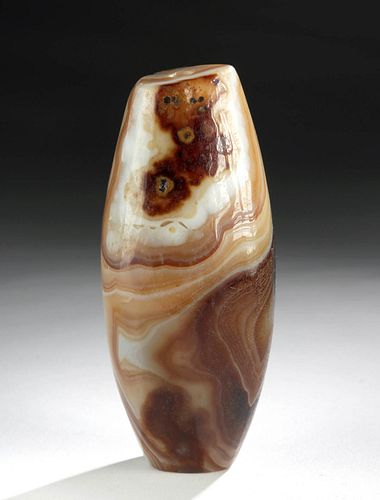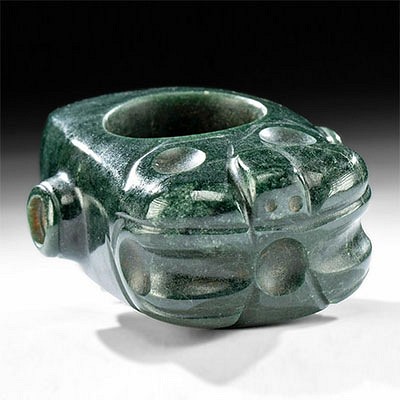Huge Antique Tibetan Agate dZi Bead
Lot 64
About Seller
Artemis Fine Arts
686 S Taylor Ave, Ste 106
Louisville, CO 80027
United States
Selling antiquities, ancient and ethnographic art online since 1993, Artemis Gallery specializes in Classical Antiquities (Egyptian, Greek, Roman, Near Eastern), Asian, Pre-Columbian, African / Tribal / Oceanographic art. Our extensive inventory includes pottery, stone, metal, wood, glass and textil...Read more
Categories
Estimate:
$800 - $1,200
Absentee vs Live bid
Two ways to bid:
- Leave a max absentee bid and the platform will bid on your behalf up to your maximum bid during the live auction.
- Bid live during the auction and your bids will be submitted real-time to the auctioneer.
Bid Increments
| Price | Bid Increment |
|---|---|
| $0 | $25 |
| $300 | $50 |
| $1,000 | $100 |
| $2,000 | $250 |
| $5,000 | $500 |
| $10,000 | $1,000 |
| $20,000 | $2,500 |
| $50,000 | $5,000 |
| $100,000 | $10,000 |
| $200,000 | $20,000 |
About Auction
By Artemis Fine Arts
Sep 10, 2020
Set Reminder
2020-09-10 10:00:00
2020-09-10 10:00:00
America/New_York
Bidsquare
Bidsquare : Antiquities | Asian | Ethnographic Art
https://www.bidsquare.com/auctions/artemis-gallery/antiquities-asian-ethnographic-art-5546
Featuring classical antiquities, ancient and ethnographic art from cultures encompassing the globe. Egyptian, Greek, Roman, Etruscan, Near Eastern, Asian, Pre-Columbian, Native American, African / Tribal, Oceanic, Spanish Colonial, Russian, Fossils, Fine Art, more! Artemis Fine Arts info@artemisfinearts.com
Featuring classical antiquities, ancient and ethnographic art from cultures encompassing the globe. Egyptian, Greek, Roman, Etruscan, Near Eastern, Asian, Pre-Columbian, Native American, African / Tribal, Oceanic, Spanish Colonial, Russian, Fossils, Fine Art, more! Artemis Fine Arts info@artemisfinearts.com
- Lot Description
Central Asia, Tibet, ca. 19th century CE. A large example of a deep brown-etched-on-white agate stone dZi bead with a chaotic banded wave form, rounded in cross-section, with a slightly bowed-out shape in the center. It is drilled through laterally. dZi beads are made of agate, with sharply delineated patterns, symmetrical shapes, strong color, and a glossy surface. Ethnographic interviews tell us that in Tibetan culture, genuine dZi beads must also be free from defilement and possess amuletic powers. Size: 4" W x 1.75" H (10.2 cm x 4.4 cm)
19th century Tibetans of every description and social standing wore large quantities of beads, made from the best materials a family could afford. For example, noblewomen wore strands of huge amber and coral beads so long that they almost touched the floor. Size and color were hugely important attributes, even more so than material. Coral, imported from Venice (alongside glass facsimiles as a more affordable option), and native turquoise were some of the most valuable, and served as both jewelry and currency. The only type of bead more precious was the dZi, black-and-white or brown beads made of etched and/or treated agate. These were made into a small variety of shapes with a large variety of patterns and were believed to be of supernatural origin. The patterns on them seem to relate to Tibet’s pre-Buddhist, animist religion. Little is known about them, in part due to Tibetan laws forbidding archaeological investigations on religious grounds. Their age and exact methods of manufacture remain nebulous - many Tibetans believe that they were not made by human hands, for example. The dZi is worn to protect against evil forces.
Provenance: private East Coast, USA collection
All items legal to buy/sell under U.S. Statute covering cultural patrimony Code 2600, CHAPTER 14, and are guaranteed to be as described or your money back.
A Certificate of Authenticity will accompany all winning bids.
We ship worldwide and handle all shipping in-house for your convenience.
#143525Natural area of loss to one side. Faint scratches and patina on surface.Condition
- Shipping Info
-
All shipping is handled in-house for your convenience. Your invoice from Artemis Gallery will include shipping calculation instructions. If in doubt, please inquire BEFORE bidding for estimated shipping costs for individual items.
-
- Buyer's Premium



 EUR
EUR CAD
CAD AUD
AUD GBP
GBP MXN
MXN HKD
HKD CNY
CNY MYR
MYR SEK
SEK SGD
SGD CHF
CHF THB
THB
















